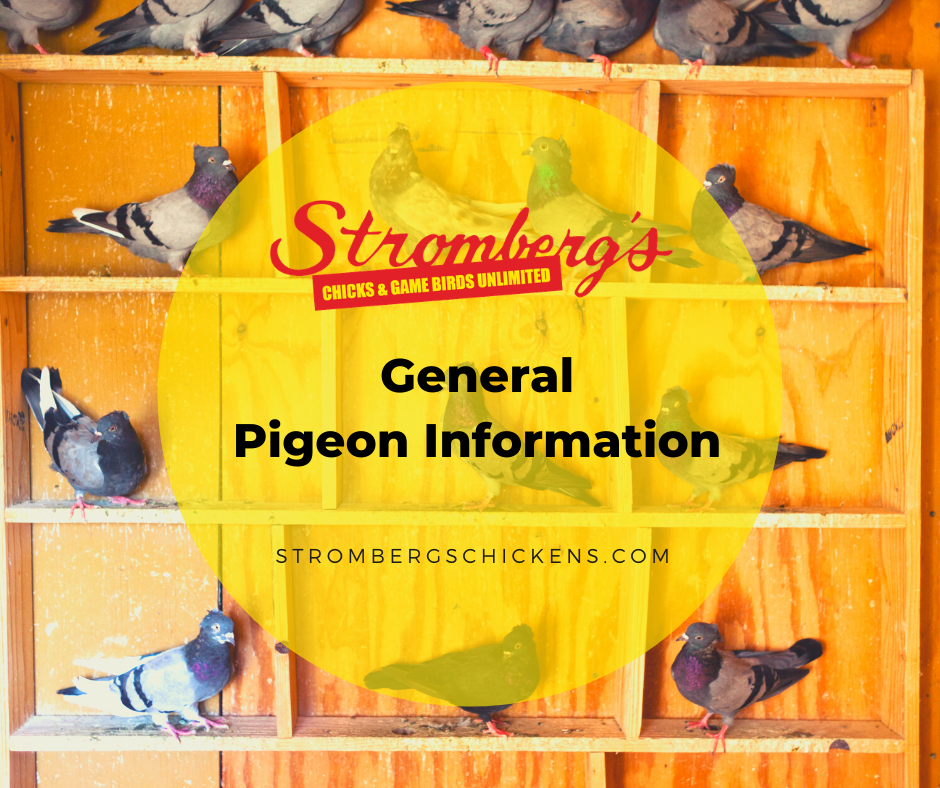General Pigeon Information
Keeping pigeons can be an exciting and satisfying hobby. As with all new adventures, reading and researching ahead of ordering and receiving pigeons is the best plan for success. We recommend the book, A Guide to Pigeon Keeping.

There are 3 fundamental groupings of pigeons: performance breeds, fancy breeds, and utility breeds. Additional management techniques may vary based on the type of pigeon you order.
Housing for pigeons can vary. Understanding pigeon behavior will enable you to construct your own loft or modify an existing structure. There is no single loft plan. This is why additional reading and reference books are essential. Housing structures for racing birds will be different than those for the fancy and utility birds.
Well-designed lofts include a secure building with a floor and protection from predators; interior nest boxes/aviary space; exterior landing board & trap; ventilation system and storage space for feed & equipment. Loft size varies based on the number of birds you plan to keep. In general, allow 8-10 cubic feet of air space for each pair. You may want to have separate interior aviary space for young birds, breeding birds, and older birds.
Commercial pigeon feed contains whole grains. In general, the birds should eat their feed within 20 minutes. Pick up the uneaten feed. Clean water daily is a must. There are many styles of waterers and feeders available. Offer grit, optimally containing trace minerals if available in your area. Provide oyster shell. Store feed in rodent-proof containers.
Always house new arrivals in a quiet area away from your other birds for about 2 weeks. Your birds will need time to recover from the stress of shipping. Your birds have been de-wormed prior to shipping with a broad spectrum de-wormer. Pigeons are sent Express Mail via the USPS.
Our pigeons are banded. The fancy and utility breeds will be banded with a sealed pigeon band from the National Pigeon Association. The race teams will be banded with an American Racing Union. We send young, non-mated, and un-flown birds.
The photos online and in the catalog are of our pigeons. There is always variation in color reproduction and more importantly not every bird hatched is an exact replica of a general picture. Young bird plumage is often different than adult plumage. Keep these factors in mind when ordering and receiving young birds.
Pigeons are becoming an increasingly popular hobby. In addition to the book, A Guide to Pigeon Keeping, there are reliable websites by many pigeon organizations where you can find additional information.
One of the most common beginner questions is how to sex pigeons. Behavior is the clue, although even the experts can be fooled. The male is usually larger and heavier than the hen.
Both sexes coo and set on eggs. In general, the male sets on eggs morning to mid-afternoon, the hen the remainder of the day. The male bows and scrapes: bowing his head toward the ground, while scraping his tail feathers on the ground. Observing mating is another way to determine males and females.
Another common question is about performance behavior. Spinning/rolling involves backward somersaults with a vertical drop. Tumbling is turning sideways at the same altitude. Young birds have the genetic propensity to perform but need the opportunity to practice and increase their skill. We cannot emphasize this enough. Education and preparation on the part of the keeper are going to make this a successful hobby. Be ready to care for and enjoy these birds upon their arrival.

